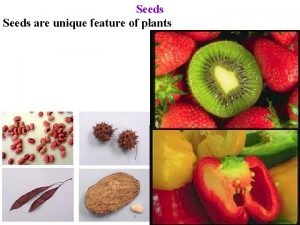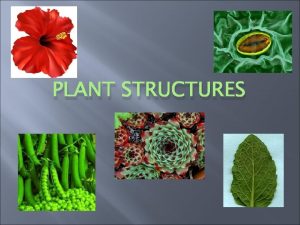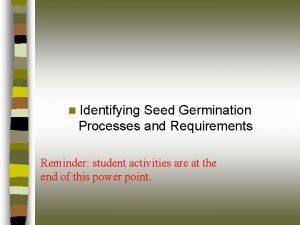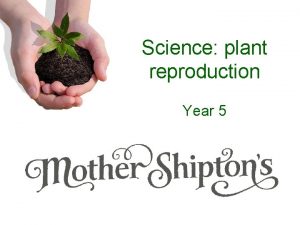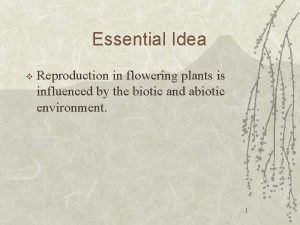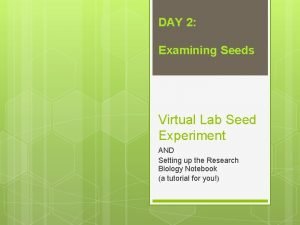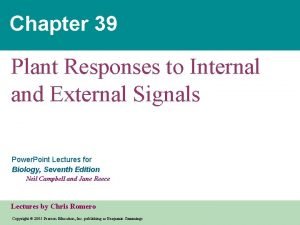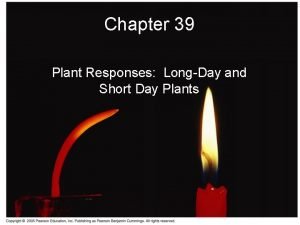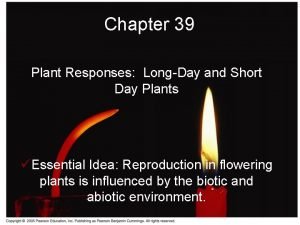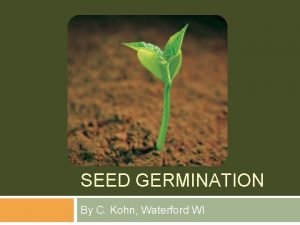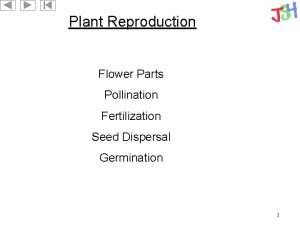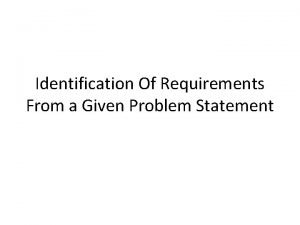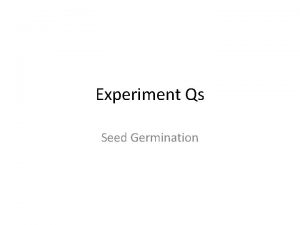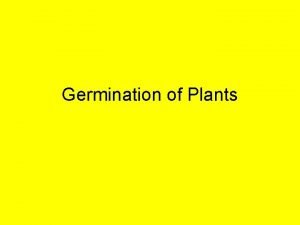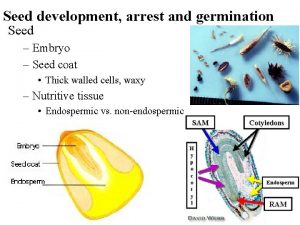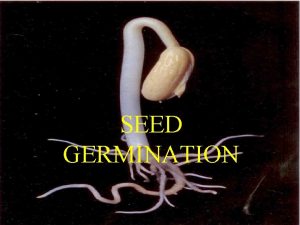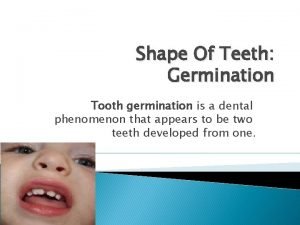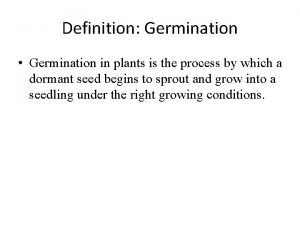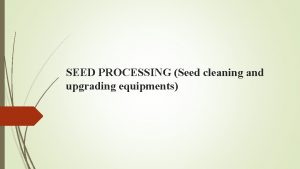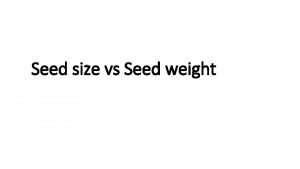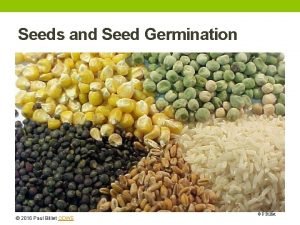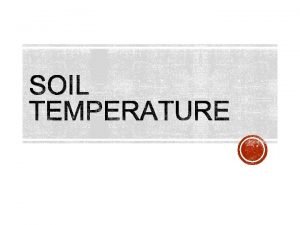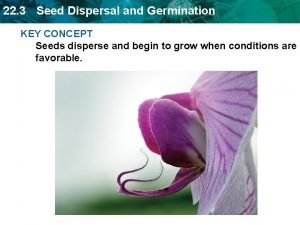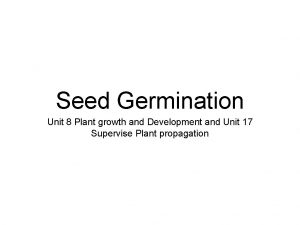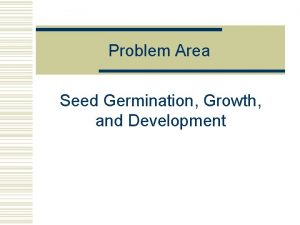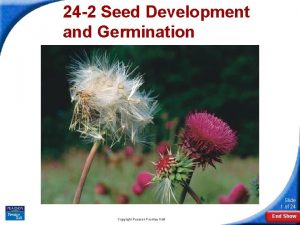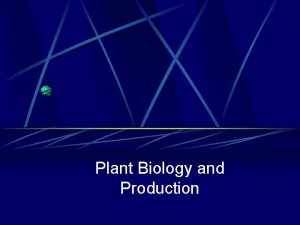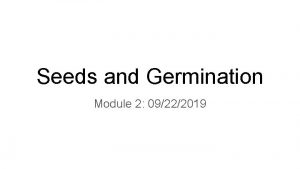n Identifying Seed Germination Processes and Requirements Reminder




























- Slides: 28

n Identifying Seed Germination Processes and Requirements Reminder: student activities are at the end of this power point.

Common Core/Next Generation Science Standards Addressed! n MS‐LS 1‐ 6. Construct a scientific explanation based on evidence for the role of photosynthesis in the cycling of matter and flow of energy into and out of organisms. n RST. 6‐ 8. 1 Cite specific textual evidence to support analysis of science and technical texts, attending to the precise details of explanations or descriptions (MS‐PS 1‐ 2) n RST. 6‐ 8. 3 Follow precisely a multistep procedure when carrying out experiments, taking measurements, or performing technical tasks. (MS‐PS 1‐ 6) n WHST. 6‐ 8. 1 Write arguments to support claims with clear reasons and relevant evidence. (MS‐LS 2‐ 4)

Career Cluster Content Standards – Agriculture, Food and Natural Resources. n Pathway Content Standard: The student will demonstrate competence in the application of scientific principles and techniques to the production and management of plants. – PS. 03. 02. Performance Indicator: Develop and implement a plant management plan for crop production. • PS. 03. 02. 04. a. Observe and record environmental conditions during the germination, growth and development of a crop.

Interest Approach Teacher: Fill a clean mayonnaise or pickle jar one half full with soybeans. Add fine textured sand shake the jar until the beans and sand are evenly distributed and the contents fills the jar to the top. Place the jar on a pan at the front of the class. At the start of class ask students to present hypotheses as to what will happen when the contents is completely saturated with water. List the predictions on the board. Fill the jar with water as you collect the student hypotheses. Use warm water to speed the process. Within 30 to 45 minutes expect the glass to crack due to the build up of osmotic pressure caused by the seeds’ imbibition of water.

Bell Work 1. Describe the process of seed germination. 2. Discuss the conditions required for seed germination. 3. Explain the importance of seed quality.

Terms Amylase Germination Imbibition Phytochrome Protease Scarification Stratification Turgid Viability Vigor

What is the Process of Seed Germination

n I. Germination is the process by which the seed embryo begins growth. A seed is considered to have germinated when the embryonic root emerges from the seed coat. Many important crops are grown from seed. Corn, soybeans, cotton, and vegetables are started from seeds. Seed germination is a complex process that begins when conditions are favorable for growth. – A. Some plants produce seeds, which germinate immediately once they are released. Others produce seeds that have internal dormancy mechanisms and remain dormant until conditions are favorable before the seed can germinate.


• 1. Stratification is a dormancy mechanism that involves temperature. Seeds with this mechanism must experience a period of cold temperature before the seed can germinate. • 2. Scarification is a dormancy mechanism that involves the breakdown of the seed coat. Some plants have very thick and tough protective seed coats. These seed coats prevent water and oxygen from entering the seed. The seed coat must be broken before germination can begin.

– B. There are three major stages in the germination process. • 1. Germination begins with the seed’s absorption or imbibition of water. Most dormant seeds have 5– 10% moisture content. When conditions are right, water is imbibed very rapidly. Most water is imbibed through the micropyle. As the cells hydrate, they swell and become turgid or rigid. • 2. In stage two, metabolic activity surges. Proteins are synthesized. Gibberellins stimulate the production of enzymes. The enzyme amylase converts stored starches to sugars. The enzyme protease breaks down stored proteins into amino acids. The sugars and amino acids are directed towards cell division, growth, and differentiation sites at the root and shoot meristems or tips. • 3. Metabolic processes increase in the third phase of germination. The swelling of cells causes the seed coat to rupture. The primary root or radicle emerges downward, and the stem grows upwards. The shoot begins manufacturing food through photosynthesis. The roots absorb water and nutrients.


What Conditions are Required for Seed Germination?

n II. Germination begins when favorable conditions exist for the survival of the developing plant. The conditions for germination include moisture, air, optimal temperatures, and possibly light or darkness. – A. Water triggers germination processes and is necessary as the embryo grows and develops. – B. All seeds need oxygen to germinate. Oxygen is required for cellular respiration, a process necessary for converting stored food into energy. Seeds germinate at a wide range of temperatures, ranging from 32°F to 105°F. However, the optimum temperature for most seeds lies between 65°F and 80°F. Temperature influences the speed of metabolic activities. Metabolism is faster when temperatures are warm than when temperatures are cool.

– C. Seeds of some plants need exposure to light before they will germinate. Seeds of other plants require darkness in order to germinate, and there are those that are not influenced by light or darkness. Seeds that are light sensitive have a photoreceptor pigment, called phytochrome, found in the seed coat. This pigment sends messages to the seed instructing it to initiate or to stop germination.


Why is Seed Quality Important?

n III. Seed quality and proper storage of seed are crucial to achieving desired high germination rates. High quality seeds produce healthy seedlings. Seed quality refers to both viability and vigor. – A. Viability is the ability of seeds to germinate under optimal conditions.

-B. Vigor is the ability of seeds to germinate under different conditions and still produce healthy plants. -C. Seed producers test seeds to determine the percentage of seeds that will germinate. Germination rates from the tests are printed on the seed container label. -D. Until the seeds are sold and planted they must be kept in storage. A goal is to maintain seed viability and vigor during the storage period. The best seed storage conditions typically consist of cool temperatures (about 40°F) and low humidity (approximately 15%).

Review/Summary 1. 2. 3. What is the process of seed germination? What conditions are required for seed germination? Why is seed quality important?

The End! NEXT: Student Learning Activities

Student Learning Activities n Sample tests are available in the Lesson Plan tab.

n Have students draw and label the germination process.

Here is an example diagram of the germination process.

Color and label the diagram of a bean seed germination below. Name: _____________

Here is an example of a bean seed germinating.


 Dicot seed germination diagram
Dicot seed germination diagram Define seed dormancy
Define seed dormancy Is sunlight necessary for seed germination
Is sunlight necessary for seed germination Conclusion about seed germination
Conclusion about seed germination Dicot seed germination diagram
Dicot seed germination diagram Seed germination process
Seed germination process Pollination fertilisation seed dispersal germination
Pollination fertilisation seed dispersal germination Rachel ryley
Rachel ryley Seed germination conclusion
Seed germination conclusion Angiosperms double fertilization
Angiosperms double fertilization Seed germination virtual lab
Seed germination virtual lab Seed germination
Seed germination Seed germination
Seed germination Seed germination
Seed germination Factors affecting seed germination ppt
Factors affecting seed germination ppt Factors affecting seed germination
Factors affecting seed germination Germinating seed
Germinating seed Identifying and non identifying adjective clauses
Identifying and non identifying adjective clauses Whats an adjective clause
Whats an adjective clause Identifying and non identifying adjective clauses
Identifying and non identifying adjective clauses Concurrent in os
Concurrent in os Problem statement in software engineering
Problem statement in software engineering Cohesive thesis statement
Cohesive thesis statement Stir you up by way of reminder
Stir you up by way of reminder Proactive patient outreach
Proactive patient outreach What dose advertisement mean
What dose advertisement mean I693 reminder letter
I693 reminder letter Growth mindset crumpled paper activity
Growth mindset crumpled paper activity Binder reminder
Binder reminder


